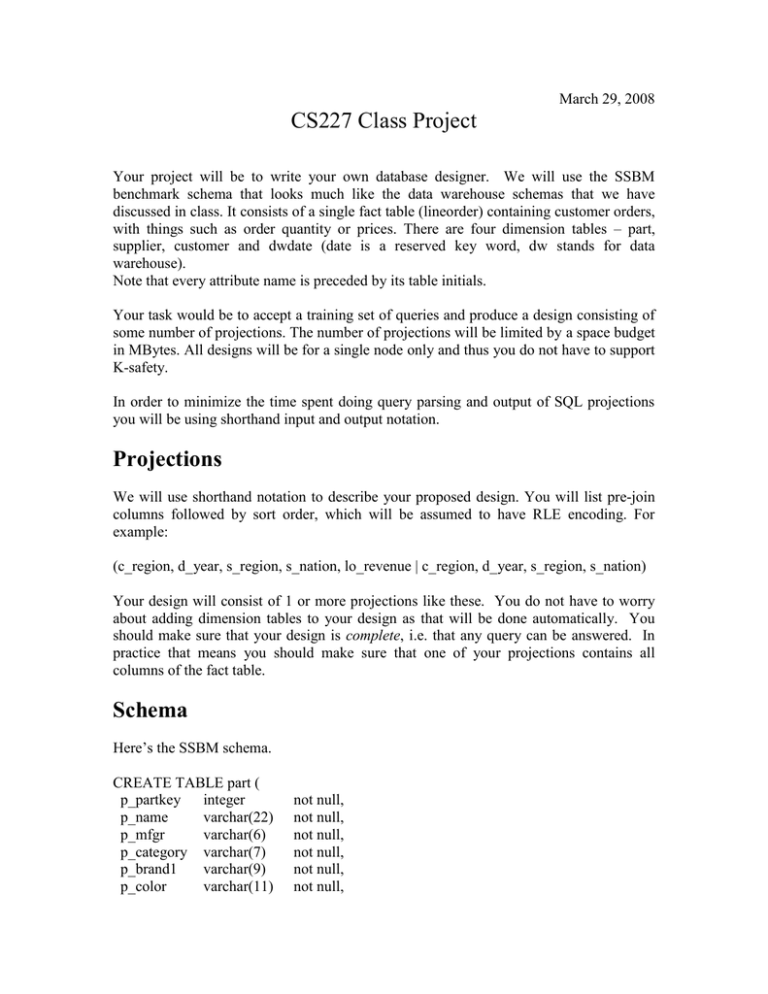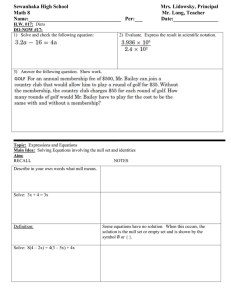CS227 Class Project
advertisement

March 29, 2008 CS227 Class Project Your project will be to write your own database designer. We will use the SSBM benchmark schema that looks much like the data warehouse schemas that we have discussed in class. It consists of a single fact table (lineorder) containing customer orders, with things such as order quantity or prices. There are four dimension tables – part, supplier, customer and dwdate (date is a reserved key word, dw stands for data warehouse). Note that every attribute name is preceded by its table initials. Your task would be to accept a training set of queries and produce a design consisting of some number of projections. The number of projections will be limited by a space budget in MBytes. All designs will be for a single node only and thus you do not have to support K-safety. In order to minimize the time spent doing query parsing and output of SQL projections you will be using shorthand input and output notation. Projections We will use shorthand notation to describe your proposed design. You will list pre-join columns followed by sort order, which will be assumed to have RLE encoding. For example: (c_region, d_year, s_region, s_nation, lo_revenue | c_region, d_year, s_region, s_nation) Your design will consist of 1 or more projections like these. You do not have to worry about adding dimension tables to your design as that will be done automatically. You should make sure that your design is complete, i.e. that any query can be answered. In practice that means you should make sure that one of your projections contains all columns of the fact table. Schema Here’s the SSBM schema. CREATE TABLE part ( p_partkey integer p_name varchar(22) p_mfgr varchar(6) p_category varchar(7) p_brand1 varchar(9) p_color varchar(11) not null, not null, not null, not null, not null, not null, p_type varchar(25) p_size integer p_container varchar(10) ); CREATE TABLE supplier ( s_suppkey integer s_name varchar(25) s_address varchar(25) s_city varchar(10) s_nation varchar(15) s_region varchar(12) s_phone varchar(15) ); not null, not null, not null not null, not null, not null, not null, not null, not null, not null CREATE TABLE customer ( c_custkey integer not null, c_name varchar(25) not null, c_address varchar(25) not null, c_city varchar(10) not null, c_nation varchar(15) not null, c_region varchar(12) not null, c_phone varchar(15) not null, c_mktsegment varchar(10) not null ); CREATE TABLE dwdate ( d_datekey integer d_date varchar(19) d_dayofweek varchar(10) d_month varchar(10) d_year integer d_yearmonthnum integer d_yearmonth varchar(8) d_daynuminweek integer d_daynuminmonth integer d_daynuminyear integer d_monthnuminyear integer d_weeknuminyear integer d_sellingseason varchar(13) d_lastdayinweekfl varchar(1) d_lastdayinmonthfl varchar(1) d_holidayfl varchar(1) d_weekdayfl varchar(1) ); not null, not null, not null, not null, not null, not null, not null, not null, not null, not null, not null, not null, not null, not null, not null, not null, not null CREATE TABLE lineorder ( lo_orderkey integer lo_linenumber integer lo_custkey integer lo_partkey integer lo_suppkey integer lo_orderdate integer lo_orderpriority varchar(15) lo_shippriority varchar(1) lo_quantity integer lo_extendedprice integer lo_ordertotalprice integer lo_discount integer lo_revenue integer lo_supplycost integer lo_tax integer lo_commitdate integer lo_shipmode varchar(10) ); not null, not null, not null, not null, not null, not null, not null, not null, not null, not null, not null, not null, not null, not null, not null, not null, not null Queries Queries are specified as a three lists: a target list, a list of predicates and group by columns if any. For example: (((lo_tax),(lo_revenue)), ((d_year = 2005), (s_region = "ASIA")), ()) Would represent a query SELECT lo_tax, lo_revenue FROM lineorder, dwdate, supplier WHERE [necessary foreign key links] AND d_year = 2005 AND s_region = “ASIA”; Or a query (((d_year, AGG), (lo_revenue, SUM)), ((s_region = ”AMERICA”), (p_category = ”MFGR#12”)), (d_year)) Would represent SELECT d_year, sum(lo_revenue) FROM lineorder, dwdate, part, supplier WHERE [necessary foreign keys] AND p_category = 'MFGR#12' AND s_region = 'AMERICA' GROUP BY d_year; You do not have to worry about ORDER BY queries. We are only going to support simple, single predicates, i.e. “=”, “>” and “<”. You should be able to handle a set of simple queries. Here’s an initial training set of 6 queries (first 6 of the 12 SSBM benchmark queries): (((lo_extendedprice, SUM)), ((d_yearmonth = ”Jan1994”), (lo_discount < 3), (lo_quanitity < 25), ()) (((lo_extendedprice, SUM)), ((d_yearmonth = ”Jan1994”), (lo_discount < 5), (lo_quanitity > 30), ()) (((lo_extendedprice, SUM)), ((d_weeknuminyear = 6), (d_year = 1994), (lo_discount > 6), (lo_quanitity > 38), ()) (((d_year, AGG), (p_brand1, AGG), (lo_revenue, SUM)), ((p_category = “MFGR#12”), (s_region = “AMERICA”)), (d_year, p_brand1)) (((d_year, AGG), (p_brand1, AGG), (lo_revenue, SUM)), ((p_brand < “MFGR#2223”), (s_region = “ASIA”)), (d_year, p_brand1)) (((d_year, AGG), (p_brand1, AGG), (lo_revenue, SUM)), ((p_brand = “MFGR#2221”), (s_region = “EUROPE”)), (d_year, p_brand1)) Data SSBM data with 24M rows in the fact table is available at these links. http://www.cs.brown.edu/people/alexr/data/customer.tbl http://www.cs.brown.edu/people/alexr/data/dwdate.tbl http://www.cs.brown.edu/people/alexr/data/lineorder.tbl http://www.cs.brown.edu/people/alexr/data/part.tbl http://www.cs.brown.edu/people/alexr/data/supplier.tbl To get this data locally, you can use /pro/web/web/people/alexr/data/ path Running Designs We will automate testing your designs. You will be able to place a design in a directory and get query runtimes/projection sizes from a Vertica installation. Details are TBA.






